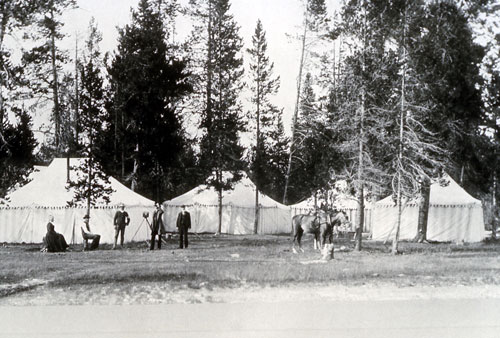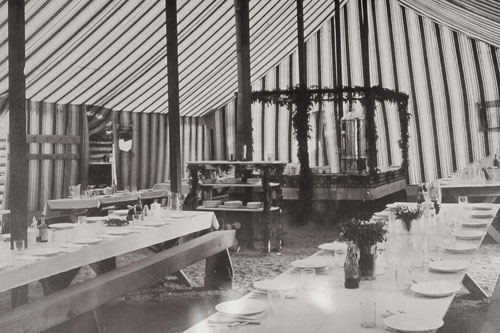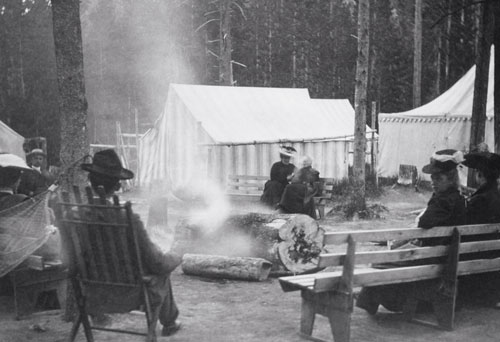Developing the Grand Canyon for scenic tourism, especially along the North Rim, was a difficult task because of its isolation from major population centers and transportation routes. Many entrepreneurs at the Canyon pioneered new ways to cater to their visitors’ demands, but they also did not hesitate to borrow ideas from other similar areas. One such idea that was begun and tested elsewhere, then exported to the Grand Canyon, was that of the “Wylie Way” form of concessions.
William Wallace Wylie is credited with originating the “permanent camp” concept in the national parks, starting at Yellowstone National Park in the 1880s. Wylie was born in 1848 and grew up in Iowa, coming to Montana at the age of 30 to become principal of the city’s schools. Two years later, in 1880, he visited Yellowstone National Park for the first time. He was so impressed with the landscape that the next year he started giving lectures on the park, and the following year he published a guidebook to it. He led guided tours of the park for teachers and visitors, making camp each night by erecting tents for cooking, sleeping, and to shelter horses and wagons. As his touring parties grew larger and larger, it became more burdensome to move this equipment around, put it up, and break it down every day.
To ease this tedious work, in 1893 Wylie asked for and received permission from the park to leave these camps standing in fixed spots. His idea was to have a camp with a central dining room and lodge surrounded by individual tent cabins. These fixed-tent camps were ideal for visitors on a tight budget, and the “Wylie Way” camp concept soon spread to other parks looking for a way to accommodate less well-heeled customers who wanted to enjoy parks without having to stay at a five-star resort with chandeliers, chamber music, and dress codes. However, these were no cheap tiny pup tents either. The tents generally had wooden floors covered by rugs, wood-burning stoves, beds, and other furniture. Families dined together in large dining hall tents, and could also enjoy entertainment such as dancing, lectures, and sing-alongs at the campsite.
Though William Wylie sold his Wylie Permanent Camping Company business in 1905, members of his family stayed involved in running Wylie Way camps. In 1917, the Union Pacific Railroad asked Wylie to open similar camps at Zion National Park and at Bright Angel Point on the Grand Canyon’s north rim.
The Railroad at the time was trying to develop a tourism industry to rival that of the Santa Fe railway, which had monopolized concessions on the South Rim. At this time, the Grand Canyon was still under control of the Forest Service, and Wylie believed that he would soon receive a long-term contract from them, making him the premier concessionaire on the North Rim, much like the Fred Harvey Company on the South Rim.
William Wylie remained at Zion to oversee his facilities there, putting the new enterprise at the Grand Canyon in the hands of his daughter, Elizabeth Wylie McKee. This was not a grand feminist gesture; Wylie had originally sent his two sons to run the camp, but they wandered for a week after getting lost on their way to the camp and returned to him without ever reaching the North Rim, refusing to live in such a remote area. Elizabeth therefore ran the camp with the help of her husband Thomas and son Robert, as well as a staff of local Mormon teenagers. The camp was located about 100 yards northwest of the modern location of the Grand Canyon Lodge near Bright Angel Point.
In the early 1920s, the Wylie Way Camp consisted of a central dining tent and sleeping tents nestled in a shady grove of pines that could accommodate 25 people for a cost of $6 per day. They rented out saddle stock and camping gear to visitors who wished to explore the surrounding area. Thomas also would lead guests on trips to Point Sublime and Cape Royal. The camp would usually open in mid-June and close the first of October. Elizabeth handled most of the accounting and was in charge of the kitchen, ordering food and other necessities. In 1922, the Wylie Way Camp became more deeply enmeshed in Canyon life when National Park Service workers constructed a single-wire, magneto-handset system that allowed for quick communication between the rims. The system linked the Wylie Way Camp on the North Rim to Phantom Ranch and Indian Garden within the Canyon, and Grand Canyon Village on the South Rim.
When her father retired in 1924, Elizabeth took full ownership of the facility.
From 1917 to 1927, this Wylie Way Camp became the main concession at the North Rim, competing with other early entrepreneurs such as Edwin Dilworth “Uncle Dee” Woolley, David Rust, “Uncle Jimmy” Owens, and Aldus and Melissa Jensen. However, despite constant pressure from Elizabeth, the NPS would only give her annual contracts for her business. This tenuous situation meant that she could not plan for and finance improvements to her camp, restricting the pace and extent of the development of tourism services on the North Rim.
In 1927, the NPS opened bidding to find the first permanent concessionaire for the North Rim. None of the small entrepreneurs could afford the improvements that the NPS required to award the contract, since the NPS had purposely designed it to attract the Union Pacific Railroad and its subsidiary the Utah Parks Company. The Railroad won the bid for the 20-year contract, and Elizabeth Wylie McKee and the other small operators had little choice but to sell out to the Utah Parks Company. The McKees continued to operate the Wylie Way Camp for the rest of the 1927 season as the Utah Parks Company spent millions of dollars creating the Grand Canyon Lodge complex. At the end of 1927, the Utah Parks Company bought up the last Wylie Camp to operate as part of its North Rim facilities, moving it to the site of today’s campgrounds.
Written By Sarah Bohl Gerke
References:
- Albright, Horace M. and Frank J. Taylor. Oh Ranger! A Book about the National Parks. 4th ed. National Park Service, 1972.
- Anderson, Michael. Polishing the Jewel: An Administrative History of Grand Canyon National Park. Grand Canyon Association, 2000.



